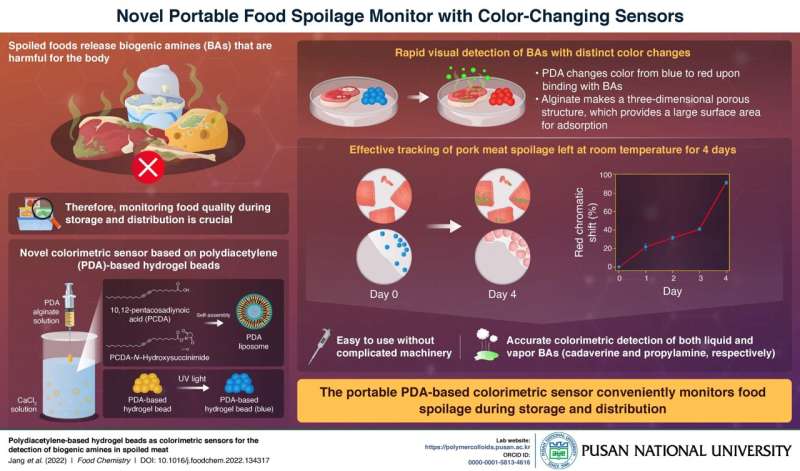This article has been reviewed according to Science X's editorial process and policies. Editors have highlighted the following attributes while ensuring the content's credibility:
fact-checked
peer-reviewed publication
proofread
Researchers develop portable color-changing food spoilage sensor

When foods like fish, meat, and cheese decompose, they release a variety of low molecular weight organic nitrogen compounds known as biogenic amines (BAs). While the body uses BAs in small amounts in processes like hormone synthesis, ingesting large amounts of BAs from spoiled food can cause serious health problems.
Therefore, it is important to detect BAs during food storage and distribution. This motivated a team of researchers, including Prof. Sungbaek Seo, Associate Professor of Biomaterials Science at Pusan National University, to develop a portable molecular sensor that quickly detects the presence of BAs by changing colors.
"The rapid and easy monitoring of deleterious BAs released from spoiled foods could alert us, prevent consumption of spoiled meat, maintain food quality, and establish further effective food storage and distribution conditions in the logistic chain," notes Prof. Seo.
The researchers have detailed this novel development in a recent article published in Food Chemistry. The team combined the distinct color-changing property of polydiacetylene (PDA)-based hydrogel beads upon binding with BAs with an alginate solution that rendered a three-dimensional porous structure with a large surface area to fabricate this novel sensor.
The researchers demonstrated that the developed sensor beads easily detect biogenic amines like cadaverine and propylamine both in solution and vapor forms via distinct changes in color from blue to red. The team further put the sensor to test the spoilage of pork meat samples left at room temperature across 4 days. They showed that the sensor beads could efficiently track the gradual spoilage over time by showing a distinct shift in the shade of color.
The sensor is made of portable, light-weight beads and does not require complicated analytical equipment or skilled personnel. It offers rapid and seamless visual detection via colorimetric change in the beads from blue to red. As Prof. Seo observes, "The portable beads could be utilized on sites for monitoring whether the food quality is okay during storage and logistic chain. Further, the beads could be applied in evaluating whether ideal food storage and distribution conditions are well-preserved".
Taken together, this portable PDA-based colorimetric sensor would facilitate the seamless monitoring of food spoilage during storage and distribution, and prevent health hazards arising from the ingestion of BAs.
More information: Soojin Jang et al, Polydiacetylene-based hydrogel beads as colorimetric sensors for the detection of biogenic amines in spoiled meat, Food Chemistry (2022). DOI: 10.1016/j.foodchem.2022.134317
Journal information: Food Chemistry
Provided by Pusan National University




















